This post covers converting a cargo van into a camper for those sensitive to mold and chemical offgassing.
I will focus only on a few key areas:
- Insulating a van in a way that will not go moldy – as metal walls are the trickiest material to insulate because of the condensation factor. Most vans are built wrong and have mold (or will go moldy).
- Low or zero-VOC healthy materials for the walls, flooring, cabinets, and interior.
- A bed platform and keeping the bed dry and mold-free.
- A few appliances that are recommended.
Building a camper that will be both mold-free and chemical-free is tricky!
Keep in mind a cargo van can be anything from a metal box with a bed to a fully decked-out camper with a stove, fridge, sink, heater, AC, and even a full bathroom.
This article contains affiliate links, upon purchase I make a small commission at no extra cost to you.
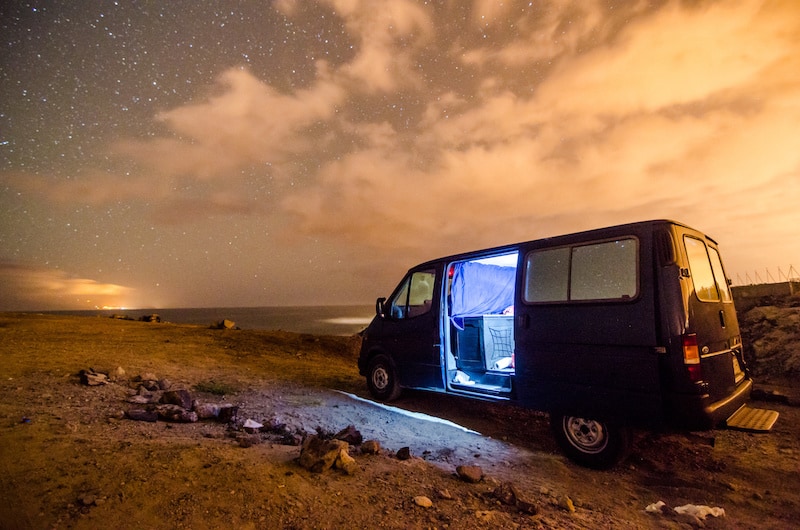
Insulating a Cargo Van to Prevent Mold
The most important aspect of creating a mold-free camper is the insulation.
Here is the key point: no water vapor can enter the wall cavity, in most heating conditions, this means no air can enter behind the insulation.
With exterior metal walls, as soon as you are heating the van to the point where the exterior wall will hit dewpoint, you have a serious risk of condensation and mold in the walls.
So again, to keep it simple, no water vapor and no air can enter the walls if you plan to heat your camper when it’s cold.
Ideally, no air at all should be trapped behind insulation if you want to be extra careful to prevent mold.
If you are in a hot or tropical climate where you don’t heat you will not have this problem of the exterior metal causing condensation.
Rigid Foam Insulation
Camp Like a Girl, a book about converting a van, had a number of flaws and misleading instructions.
The writer uses some XPS and some EPS insulation. XPS is a vapor barrier (meaning no water can pass through 1.5 inches), and EPS is not.
Using XPS foam is one option to insulate your van. XPS or polyiso with foil backing are usually tolerable for most people with MCS.
However, just the foam on its own will not be airtight. You need canned spray foam to fill in the gaps if that is tolerable for you – the thorough system to prevent mold that is working in vans, and was reviewed by a top building science expert, is to fill in the area behind the foam with spray foam and squish it in, leaving no air behind anything.
You need to fill in all the crevices that are not big enough to take rigid foam with spray foam as well.
One-part canned spray foam is not chemical-free, but I have found it odorless once cured. You will have to see if it works for you if you are sensitive to chemicals.
Handi-Foam is the safest one, as it is GreenGuard Gold certified. Great Stuff will work for many people. This method involves a lot of canned spray foam.
You can also buy one-part in larger quantities, I am currently testing out this DAP liner to attach foam to walls. They claim this is closed-cell foam.
The rigid foam also then needs to be riveted to the frame.
I would not recommend the method in Camp Like a Girl of putting in EPS and not sealing it – this leads to condensation. Because she barely heated the van, and had hot temps in the day, this did dry out in the day and did work in those desert conditions.
Any foam with air behind can be a problem when heated. Breathable insulation is even more tricky. A few cold days in a row and this will start to be a problem. (I would never use wool insulation in a van, the only exception is very hot climates where you will never be heating the van).
A good way to go about it – if it’s warm enough – is to sleep in the van empty and slowly work on insulating and building it out. The other option is to get it all done and then wait for it to offgas.
Rigid Foam in the Bed
Some have used insulation in the bed platform to keep the bed warm. I would be concerned here with flame retardants in the foam, and putting a bed on a flat surface is a no-no for mold.
In the bed section, I discuss how to use insulation under the mattress without causing moisture and mold.
Spray Foam Insulation
Spray Foam without any rigid foam is, in theory, your safest bet for preventing mold. The foam will get into every crevice and form an airtight layer that will prevent all moisture from getting into the walls.
Two-part spray foams are much riskier than the one-part canned spray foam discussed above.
A reputable and very experienced installer is more important than the brand, as that is where the process goes wrong and can cause it to fail to cure properly. This causes major offgassing that may not stop.
I might recommend these to healthy people who are set on spray foam. I don’t usually recommend them to people with MCS because of the possibility of prolonged offgassing.
The companies say they do not offgas, but I have seen many stories from moderately sensitive people that this does offgas noticeably in buildings. A small sample may air out quickly, but test this in a building before using it.
At least two years (if this is installed correctly) may need to be scheduled into offgas this for the moderately sensitive. If not installed correctly it’s a goner, you’re going to be scraping out the whole thing.
If you are mold-sensitive but not chemically sensitive you could consider this in a van. I have heard though, both in Airstreams and in vans, stories of spray foam pushing out the frame in areas causing problems. A skilled installer may be able to clarify why this happens.
Spray foam is also prone to pulling away from the walls, especially in a moving vehicle.
Airstream as well as Winnebago, have moved away from two-part spray foam due to problems.
Wall and Ceiling Materials
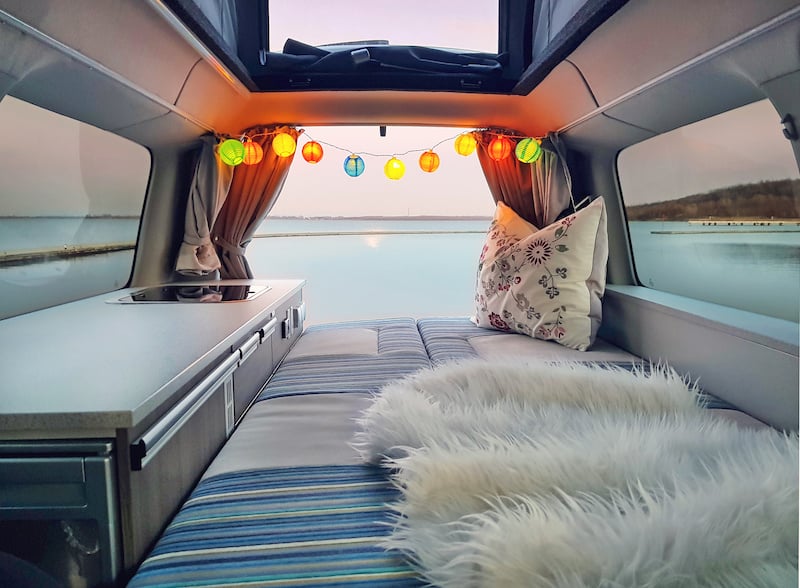
Metal is your safest bet unless you are putting the plastic covers back on.
If you do put the plastic covers back on, caulk around the seams to prevent moisture from going into the walls.
If you want your interior walls to be another vapor barrier layer, the metal or plastic should be used and caulked airtight.
If tin/aluminum tiles are used it’s best that behind them is airtight (though if you have enough insulation this might not be necessary). If you don’t have enough insulation, you could have condensation behind the wall cover.
Some folks are putting canned spray foam behind the tin tiles for an extra layer of air sealing.
I have also seen gaskets with solid silicone sheets used to make the walls airtight.
In a cargo van or trailer, instead of using metal walls, my preference would be to keep the walls as simple as possible so that you can open them up to check on problems.
You may want to use plastic sheets, or could simply tack up and cover the foam with the material of your choice:
- Silicone “leather” which comes in rolls
- Polyurethane leather
- Polyester fabric murals
- The grey side of house wrap (which looks cool)
- Painted foil or metal walls with AFM metal paint
- Polyethylene wall tiles (if you can tolerate the glue)
- Seal everything with shellac and then paint directly over XPS
There is no reason to use PVC, the most toxic plastic, in areas like the ceiling tiles. But real tin ceiling tiles could be used as a non-toxic alternative which also adds a fun look to your camper.
While The Vanual, a popular van conversion, looks very pretty with its wooden ceiling, I would avoid plywood as walls, ceiling, or subflooring. There are just too many points where the wood hits the metal.
If you are intent on getting this look, you would have to have lots of insulation at all the metal ribs to make sure dewpoint would never be hit there.
If that is possible, then you could use plywood with strips of wood over it to get the look in The Vanual. Use a wood that can take high humidity.
Floor Materials for a Van
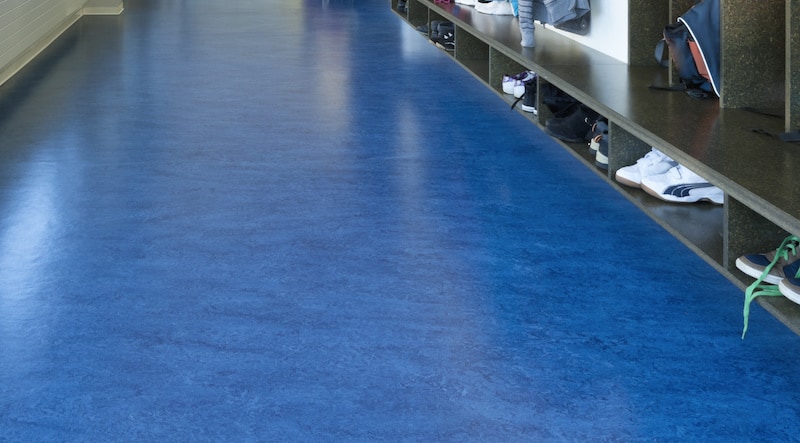
I wouldn’t use wood to raise the floor joists as the wood right against the metal is usually a recipe for condensation and mold.
Rigid foam may be your best bet for floors to solve the thermal bridging there, with the same system of canned spray foam above and riveting used to make it 100% airtight.
Flooring materials that could be considered include:
- Metal sheets, which could be painted with AFM Metal Primer with different designs for a pretty effect, or covered with rugs.
- Marmoleum. Be careful here as Marmoleum sheet (the rolls) has a jute backing. The modular tiles, have a synthetic plastic backing which is better. Use plenty of insulation underneath and an underlayment with a thermal break to prevent condensation.
- Plastics: Hard plastic sheets like plexiglass, rolls of silicone, EVA mats.
- Plastic-based flooring: plastic rugs, or luxury vinyl planks (LVP). Both are extremely low in offgassing, though still could be bothersome for some folks. You could also use polyurethane sheet flooring which is practically odorless.
- Garage flooring: super-duper easy to install. The brand in Europe is Bergo but in the US there are a number of them on Amazon like GarageTrac.
- Cork Flooring: Ff you are sure you have enough insulation underneath to prevent condensation from forming under the cork and a thermal break then a waterproof cork made with a plastic PET binder can work well.
Subfloor
If you are concerned about denting, use hard plastic sheets (plexiglass) or metal sheets.
Interior Structures: Bed, Cabinets
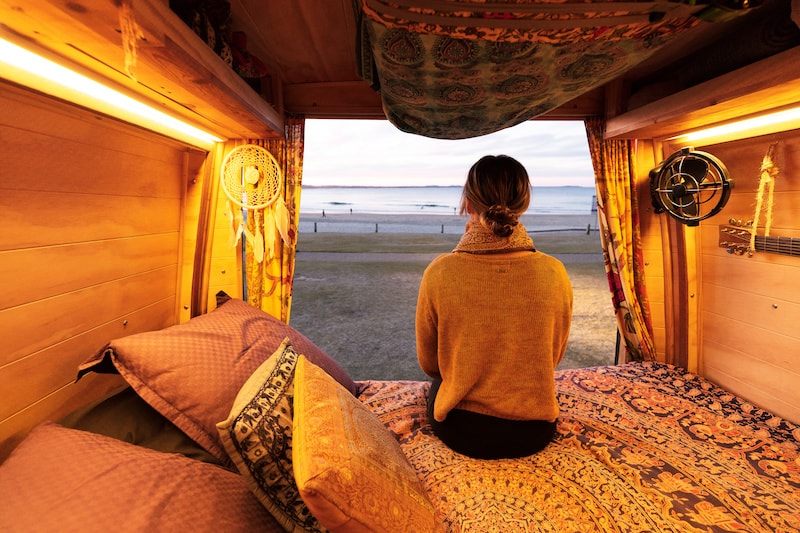
Bed Platform – Non Breathable Set up
Camp Like a Girl and The Vanual used plywood for their bed bases. If it’s softwood plywood it needs a little time to offgas formaldehyde.
The other option is formaldehyde-free Purebond plywood (but I wouldn’t use a non-moisture-resistant wood species in a van or small trailer if you will have high humidity).
Purebond does come in moisture-resistant species, even cedar. The glue is not made to withstand high humidity but should work in many vans.
It also doesn’t let the mattress breathe. Mattresses are very susceptible to becoming damp in campers. Even in a house, one should never put a regular breathable bed on a solid surface.
To prevent this moisture transfer there are two strategies to use on a platform.
One, cover the mattress with a waterproof protector before installing it on the camper platform.
The other option is to use a bed that doesn’t transfer moisture and doesn’t mold, like a non-toxic air mattress (takes only a couple of days to offgas to my standards).
An air mattress won’t keep you warm. I use the thickest Thermarest which is more comfortable than an air mattress for me (took a week or so to offgas enough for me) and I put a waterproof cover on it.
If you want to add insulation, I would add cork sheets (Thermacork brand), this is healthier than foam because of the flame retardants in foam. You could use Schulter foam boards, these are made for a shower but are the same type of foam used in insulation. They are the only foam boards with no flame retardants.
Bed Slats – Breathable Option
Another strategy is to have the bed base made of planks/slats that allow some airflow. With this strategy, you may be able to use a bed that is not covered in plastic or isn’t an air mattress.
Either way, the bed should be flipped and checked often for dampness, especially if you cook or shower inside.
I would use bedding made of polyester, wool, or silk, (and not cotton) because these are more resistant to the high humidity in vans.
How to keep warm in a bare metal van
Since insulation is so tricky, many mold avoiders keep the van bare. The best way to stay warm is to have insulation below you and above you.
Extra protection from the elements would be to add a canopy over the bed and a heat source.
Insulate Under You
I like the method of adding insulation below you. There are a few ways.
A thick Thermarest like the Mondo King provides insulation under you. Or just a slab of polyurethane foam (I have used both).
But I like the idea of adding a layer of insulation below that. I like Thermacork, a pure cork insulation. You could use foam: EPS polystyrene (Schulter brand boards).
You then add your waterproof layer to your bed. Then add a biomat or heating blanket.
Above you, you have your sleeping bag/blanket.
Stay Even Warmer by Creating a Canopy or Tent Inside
You can go one step further to stay warm and create a canopy or use a raised up tent inside the van. Anything to create a canopy – using the fabric of your choosing (as long as you have enough air) will keep this even warmer.
If the area inside my tent or canopy is large enough for this to be safe – I add a tiny heater. I used a 250-watt heater in all my small structures. Be careful!! you need to take a lot of precautions when adding a heater in a small space. Make sure you have enough clearance.
Cabinets
For cabinets, if you do use plywood, go for a formaldehyde-free plywood like Purebond (moisture-resistant wood types only – the glues might not hold up to extreme humidity), offgassed APA exterior plywood, or use solid wood (which may warp in high humidity).
I much prefer metal cabinets.
You could also use polypropylene cabinets.
Ventilation in a Van
You need fans that move air out – one above the shower if you have one, and one in the general space.
My CampLite trailer had two fans and we still have problems just with cooking humidity making the mattress wet.
The standard camper fans are called Fan-tastic.
Van Appliances
The Vanual has some cool tips for solar power, wiring, and appliances.
If you want to go off-grid you will need solar. And you generally will need to tolerate a fuel stove.
The Vanual and other van owners speak highly of Goal Zero solar systems because of how easy it is to install. Some people just use the solar charger outdoors.
The other option is to wire the van to plug into a campground plug (or modify it to plug into a house), this would allow you to cook on an electric hotplate and would allow an electric heater.
Right now I use an Instant Pot to cook everything and I release the steam outside. This is a really good way to reduce moisture in a van or little trailer. You can cook almost anything in that.
Using an electric blanket is a good heating option to save energy. The best kinds are the large ones with the 10-hour shut off time to keep you warm all night. If you don’t tolerate those, a biomat may be better tolerated.
I would not use the stand-alone propane heaters that go inside as they will not be safe for those with MCS.
For cooking, if you are off the grid you will need to burn some fuel to cook. Cooking outdoors is safer. Alcohol burning stoves are safer than propane. Though this won’t be tolerable for many.
For a fridge, I would go with a 2-way or 3-way fridge that can run on propane solar or AC electricity.
Keep in mind, unlike in most trailers, propane is stored inside in vans, so this could become a problem for some.
The Vanual recommends running this fridge on solar or the car battery.
Here is an example of a fully decked-out custom van made for someone with MCS (you would want to see how the construction was done if you wanted to copy or buy this one).
Choosing a Van
Sensitive folks have reported liking the big 4: Nissan NV, Dodge Ram Promasters, Ford Transits, and Mercedes Sprinters.
Some have found that Chevy and GMC were not as good for people with chemical sensitivities.
Anyone sensitive should check out a number of brands. And of course, there are differences between the brands in terms of size and height and all kinds of things.
Corinne Segura holds certificates in Building Biology, Healthier Materials and Sustainable Buildings, and more. She has 10 years of experience helping others create healthy homes.
Did you find this post helpful? If so you can buy me a coffee to support the research behind this blog. Thank you!
Carl Grimes, Certified Indoor Environmental Consultant, reviewed the mold-preventative insulation system for vans. Extreme mold avoiders are using this system with success.
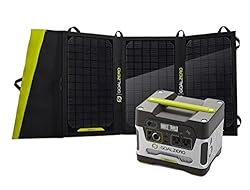
Karen
Hi Corrine,
Could you let me know when you will do phone consults again? I’m looking for a van or car to be a short term getaway, a respite for me in all seasons for when my rental apartment periodically becomes too compromised -and it always does periodically, when landlord is doing, say, building “improvements”.
So I could use advice on best cars, vans, etc., and must it be built-up, or can I manage with minimal changes? Could I get away with car/van sleeping in a New England winter, or would moisture problems and cold be insurmountable. I’m researching this myself, of course, but at some point could use the advice of someone who sees the bigger picture, and also knows about MCS issues,
Corinne
I don’t have a return date.
EG
Hi, how do you know there’s zero air in the insulation? I have no experience building so I’m not trying to be a smarty pants, but in my mind, it seems almost impossible to insulate every millimeter of space and to know for sure that you’ve done so. Thanks!
Corinne
if you put spray foam behind the rigid foam that will do
RD
Thank you Corrine for all the information you have put out, very very helpful!
I was thinking of getting epoxy floor for garage, is it ok to have epoxy flooring in garage? once fully cured does it still off gas?
Thanks,
RD
Susan Shaver
I found this worrisome for things like foam and plastic. Both for off gassing and heat, and especially a fire.
I am surprised you have not recommended Havelock wool for insulation. Can you explain?
Katie
Hi Corinne!
Can you describe how to frame without wood touching metal?
Also, what do you mean by “riveting” the rigid foam?
Thank you for this excellent resource!!
Jamie
Hi Corinne, I am converting a Ram Promaster and I am trying to figure out the best way to insulate below the subfloor. There are ridges in the floor, it’s not flat, so many people (non mcs) use minicell foam cut into strips or something of that nature. My brother used it and it took a long time to offgass, very smelly. It did offgass tho, eventually, but not sure about long term effects or using adhesive. Any suggestions for an alternative or would offgassed minicell be ok? Thanks in advance.
Corinne
I would do it the same way as the walls, one part canned spray foam to fill in gaps and then plop the rigid XPS down.
M. Waters
Before I read your ideas, my thought about turning my minivan into a campervan was to keep it simple by placing reflectix over top of the original carpeting, which I assume(?) is .mold free, then laying an area rug over the reflectix. Does this sound safe from cold, and mold?
Corinne
It’s not ideal but it could work if it’s totally dry (including humidity) behind the reflextic and it’s 100% airtight from both directions.
Evangeline Elmendorf Greene
Corinne, you mention hard plastic sheet as a flooring possibility. Do you mean thick plexiglass? Could you provide a link?
Corinne
yes plexiglass, acrylic or even polyurethane can be made into hard sheets. They have some at home depot.
MJ
What do you think of the Isotherm brand fridge and freezer?
Philip Walsh
Corinne – Have you looked at sheep’s wool? It is a keratin so mold and mildew resistant. It breathes so moisture is managed dynamically and it’s an all natural product so no offgassing. Thanks.
Dave
I’m not sure I agree with all points, especially trying to keep your van air tight behind insulation. It is virtually impossible, and in a metal box, you WILL have moisture buildup, that WILL need to dry out at some point, otherwise you will inevitably have mold / mildew. Adding a moisture barrier will only prolong your exposure to the inevitable… Conventional buildings are designed to breath. Conventional insulations get the majority of their R value from Air gaps. Building wraps such as tyvek, are a breathable membranes, so that the interiors do not trap moisture in the form of condensation. Wood structures are far less conductive than metal, so It’s even more important that a van / metal box be able to breath, IMO… I’d love to hear otherwise.
Corinne
No this is harmful information, especially considering vans and metal buildings are so moldy. A van, cargo trailer and other metal building that does not have a rainscreen cannot breathe. It is an exterior vapour barrier making it an incredibly tricky thing to insulate in heating climates. The only reasonable option for mold prevention in heated climates is to foam this in in an airtight way. A double vapour barrier is not appropriate, too risky, and just an exterior vapour barrier is definitely not appropriate in heating climates and it will mold up.
Sara
Hi Corinne,
Do you have an opinion on the use of sheep’s wool for insulation?
Thanks,
Sara
J
If I need to put some wood or plywood against the metal, would it be better to put for example vapor barrier tape (or something else?) Between the wood and metal
Thanks!
Anonymous
Would phenolformaldehyde plywood be okay to use if the formaldehyde value is only 0.018ppm? So it's much under CARB 2 which is 0.05ppm.
Thanks!
Corinne
Where did you get the 0.018 ppm value?
Corinne
A used van may or may not have mold problems and or leaks.
Aviva
Hi Corinne, I'm so glad I found your website! This is great information. Do you think someone mold-sensitive can convert a used van into a safe living space, or does it have to be basically brand new?
Cort Johnson
Thanks for all the ideas. If you want to spend a ton of money on a product with questionable reliability go with Goal Zero. Otherwise put in your own battery, charge controller and solar. Definitely do not buy solar panels from Goal Zero – at 4 times the cost of other panels.
Thanks again for all the info though
Corinne
Hey Cort! Thanks for the feedback. Everyone I know building a cargo van camper is using Goal Zero! Any idea why?
Cort
Lots of nice advertising. A couple of years later the Bluetti and similar systems look really good. If I was starting over I would probably go with them.
Leslie
Hi, Corinne–I think that it's appealing to people who are unfamiliar with and intimidated by setting up a 12-volt system, because it's plug-and-go. While it is convenient (until it breaks), I agree with Cort that it's WAY overpriced. For the money one would save, one could hire a consultant to put together a nice little solar system. Also, I've had such bad experience with their customer service that I wouldn't buy any of their products again, personally.
Corinne
Thanks for the info on solar. Not my area of expertise!
charlie puth
Thanks for comment